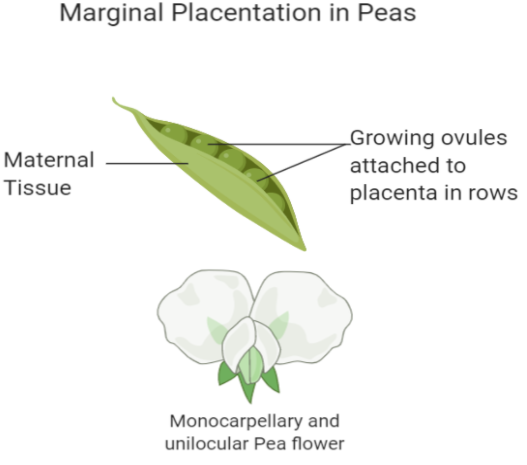
How many plants in the list given below have marginal placentation?
Mustard, Gram, Tulip, Asparagus, Arhar, Sum hemp, Chilli, Colchicine, Onion, Moong, Pea, Tobacco, Lupin.
A. Five
B. Six
C. Three
D. Four
Answer
485.1k+ views
Hint:
Complete step by step answer: The placentation in an ovary depicts the pattern of arrangement of its ovules. There are many types of patterns in which the ovules can be arranged. One of these patterns is called marginal placentation. In this type of placentation, the ovules are arranged or placed along two rows. The arrangement takes place below the surface of the ovary that is on its ventral side. The placenta forms a central margin over which the ovules are attached on both sides making two rows. This type of placentation is quite evident in peas. In peas, we see that when we open it, there is a central margin to which the peas are attached in two rows. Moreover, this type of placentation occurs in monocarpellary plants and unilocular ovaries. This means plants that have a single female reproductive unit and a single chamber inside the ovary respectively.

Now, let us see which of the given plants are monocarpellary and unilocular.
Gram, Arhar, Moong, Pea, Lupin, and Sun hemp are the plants that show marginal placentation as they are monocarpellary and unilocular.
Hence, the correct option is option B, i.e., Six.
Note: Placentation plays an important role in the ovary. It acts as a nutrient and waste transfer system for the growing seeds. It passes nutrients and water from the maternal tissue to ovules. Also, it helps in gaseous exchange and sometimes in waste removal.
Complete step by step answer: The placentation in an ovary depicts the pattern of arrangement of its ovules. There are many types of patterns in which the ovules can be arranged. One of these patterns is called marginal placentation. In this type of placentation, the ovules are arranged or placed along two rows. The arrangement takes place below the surface of the ovary that is on its ventral side. The placenta forms a central margin over which the ovules are attached on both sides making two rows. This type of placentation is quite evident in peas. In peas, we see that when we open it, there is a central margin to which the peas are attached in two rows. Moreover, this type of placentation occurs in monocarpellary plants and unilocular ovaries. This means plants that have a single female reproductive unit and a single chamber inside the ovary respectively.

Now, let us see which of the given plants are monocarpellary and unilocular.
Gram, Arhar, Moong, Pea, Lupin, and Sun hemp are the plants that show marginal placentation as they are monocarpellary and unilocular.
Hence, the correct option is option B, i.e., Six.
Note: Placentation plays an important role in the ovary. It acts as a nutrient and waste transfer system for the growing seeds. It passes nutrients and water from the maternal tissue to ovules. Also, it helps in gaseous exchange and sometimes in waste removal.
Recently Updated Pages
Master Class 9 General Knowledge: Engaging Questions & Answers for Success

Master Class 9 English: Engaging Questions & Answers for Success

Master Class 9 Science: Engaging Questions & Answers for Success

Master Class 9 Social Science: Engaging Questions & Answers for Success

Master Class 9 Maths: Engaging Questions & Answers for Success

Class 9 Question and Answer - Your Ultimate Solutions Guide

Trending doubts
State and prove Bernoullis theorem class 11 physics CBSE

What are Quantum numbers Explain the quantum number class 11 chemistry CBSE

Who built the Grand Trunk Road AChandragupta Maurya class 11 social science CBSE

1 ton equals to A 100 kg B 1000 kg C 10 kg D 10000 class 11 physics CBSE

State the laws of reflection of light

One Metric ton is equal to kg A 10000 B 1000 C 100 class 11 physics CBSE




